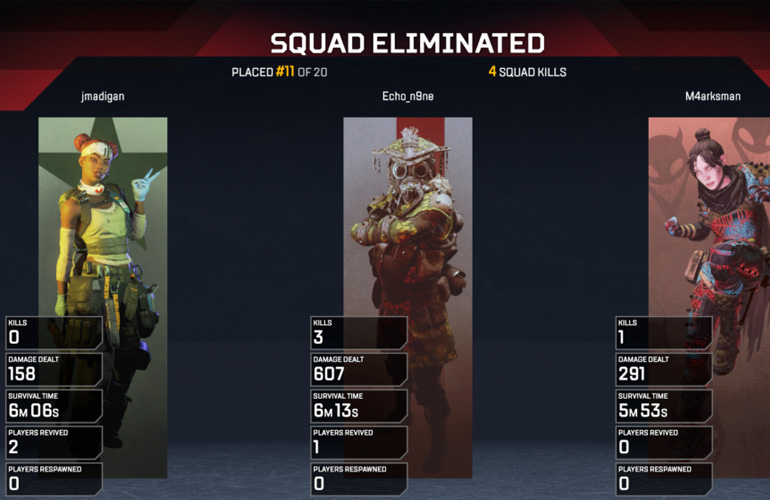0484 - 239 1149
06
Dec
Apex Fish in a Small Pond

Like a LOT of people recently, I’ve been playing the new battle royale, free-to-play shooter, Apex Legends. Since I am compelled by an ancient curse to ponder the psychology related to every game I play, I’ve also been thinking about how various psychological principles come into play with this game. Let’s review one of them.
Apex Legends forces you to group up with other players into a three-person squad and compete against 19 other groups of the same size. One of the things that caught my eye pretty much after my first match ended prematurely was this screen:
It made me think of a phenomenon in psychology called the “big fish, little pond effect.” The gist is that those who are ranked at the top of a poorly performing group tend to feel better about their performance relative to those ranked near the bottom of a highly performing group. You’d rather be a big fish in a small pond than a small fish in a big one.
I wrote about this extensively in my book Getting Gamers: The Psychology of Video Games (now available in paperback, dontchaknow?). Here’s an excerpt that’s relevant to Apex Legend’s the big fish, little pond:
“All of these emotions, especially fear, whip people up into a state of alarm and they become angry and almost evangelical about what they believe,” says Senko. “It’s like a disease infecting millions of people around the country.”
If this election cycle is a mirror, then it is reflecting a society choked with fear. It’s not just threats of terrorism, economic collapse, cyberwarfare and government corruption – each of which some 70 percent of our citizenry is afraid of, according to the Chapman University Survey on American Fears. It’s the stakes of the election itself, with Hillary Clinton at last month’s debate conjuring images of an angry Donald Trump with his finger on the nuclear codes, while Trump warned “we’re not going to have a country” if things don’t change.
Meanwhile, the electorate is commensurately terrified of its potential leaders. According to a September Associated Press poll, 56 percent of Americans said they’d be afraid if Trump won the election, while 43 percent said they’d be afraid if Clinton won – with 18 percent of respondents saying they’re afraid of either candidate winning.
Trump’s rhetoric has only served to fan the flames: “They’re bringing drugs. They’re bringing crime. They’re rapists.” “It’s only getting worse.” “You walk down the street, you get shot.” Build a wall. Ban the Muslims. Obama founded ISIS. Hillary is the devil. Death, destruction, violence, poverty, weakness. And I alone can make America safe again.
But just how unsafe is America today?
According to Lewis & Clark College president Barry Glassner, one of the country’s leading sociologists and author of The Culture of Fear, “Most Americans are living in the safest place at the safest time in human history.”
Around the globe, household wealth, longevity and education are on the rise, while violent crime and extreme poverty are down. In the U.S., life expectancy is higher than ever, our air is the cleanest it’s been in a decade, and despite a slight uptick last year, violent crime has been trending down since 1991. As reported in The Atlantic, 2015 was “the best year in history for the average human being.”
So how is it possible to be living in the safest time in human history, yet at the exact same time to be so scared?
Because, according to Glassner, “we are living in the most fearmongering time in human history. And the main reason for this is that there’s a lot of power and money available to individuals and organizations who can perpetuate these fears.”
For mass media, insurance companies, Big Pharma, advocacy groups, lawyers, politicians and so many more, your fear is worth billions. And fortunately for them, your fear is also very easy to manipulate. We’re wired to respond to it above everything else. If we miss an opportunity for abundance, life goes on; if we miss an important fear cue, it doesn’t.
“The more we learn about the brain, the more we learn it’s not something that’s supposed to make you happy all the time,” says Andrew Huberman, a Stanford neurobiology professor who runs a lab studying fear. “It’s mostly a stress-reactive machine. Its primary job is to keep us alive, which is why it’s so easy to flip people into fear all the time.”
In other words, our biology and psychology are as flawed and susceptible to corruption as the systems and politicians we’re so afraid of. In particular, when it comes to assessing future risks, there is a litany of cognitive distortions and emotional overreactions that we fall prey to.
Many believe the amygdala, a tiny, almond-shaped region deep in each hemisphere of the brain, is the home of our emotional responses, specifically fear. The author Daniel Goleman has coined the term “amygdala hijacking” to describe what inflammatory rhetoric and imagery are designed to do: trigger the emotional brain before the logical brain has a chance to stop it. This is what both the right and the left believe their opponent’s media are doing to people.
So in order to resist being manipulated by those who spread fear for personal, political and corporate gain, it’s necessary to understand it. And the first thing to understand is that although the emotion may look like fear, sound like fear and smell like fear, neuroscientists argue that it is actually something quite different. . . .
